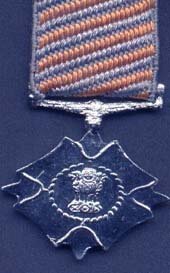
|
|
In effect, the Vayu Sena Medal serves as a sort of general commendation medal for the Indian Air Force. In some cases, it is also awarded for gallantry. From 1 February 1999, the central government set a monthly stipend of Rs. 250 for recipients of the award when it is awarded for bravery. Established: 17 June 1960, by the President of India. Obverse: A four-armed silver star with the points shaped like lotus blooms. In the center, the national emblem. Suspended by a straight bar suspender and normally named and dated on the edge. For a more detailed depiction of the obverse, see this. Reverse: A Himalayan Eagle with wings spread, and the legend, above and below, in Hindi "Vayu Sena Medal" or "Air Force / Medal". Ribbon: 30 mm, alternating 2 mm diagonal (lower left to upper right) stripes of gray and orange-saffron. The ribbon has an overall "woven" appearance.
Awards: To understand the award better, a sample recipient would be that of the second-award bar to Squadron Leader Harchand Singh Gill, Indian Air Force: "In October 1953, a composite column of Assam Rifles and a Civil Administrative party was attacked by armed Tagins and some officers and men were killed. Sqn-Ldr. H. S. Gill was in command of the detachment of Dakotas for the airlanding of troops. The work of airlanding personnel and supplies on the two small available landing grounds was difficult. Notwithstanding the difficulties Sqn.-Ldr. Gill with his keen enthusiasm, boundless energy and courage personally carried out the major portion of the landings at Doporijo. By his tireless work, the airlift which had appeared impossible, became a reality. He showed courage and devotion to duty of the highest order." |

 Awarded to all members of the Indian Air Force "in recognition of such individual acts of exceptional devotion to duty or courage as have special significance for the Air Force." Posthumous awards may be made and a bar is authorized for subsequent awards of the Vayu Sena Medal.
Awarded to all members of the Indian Air Force "in recognition of such individual acts of exceptional devotion to duty or courage as have special significance for the Air Force." Posthumous awards may be made and a bar is authorized for subsequent awards of the Vayu Sena Medal.